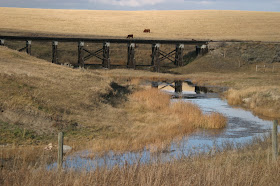The newly released Obesity in
Canada report announces that one in four Canadians are obese. Now is the time
to talk about fats.
Dietary fats are given a lot of
bad press. It is true they have twice as many calories as proteins and
carbohydrates but they carry and allow the absorption of essential nutrients
such as Vitamins A, D, and E. Fats also provide a feeling of satisfying your
hunger. You need fats in your diet but it is important to monitor the amount
and quality. The amount of fat you require depends upon your age.
Fats are categorized as
unsaturated, saturated and trans. Unsaturated are the healthiest and trans fats
are the least desirable. The two main types of unsaturated fats are
monounsaturated and polyunsaturated. Vegetable oil, nuts and seeds and avocados
fall into the category of monounsaturated. Fish, fish oils, some nuts and seeds
and some vegetable oils are polyunsaturated. These oils provide essential
omega-3 and -6 fatty acids.
Saturated fat, which raises LDL
or bad cholesterol, is found in animal foods like beef, chicken, lamb, pork and
veal, coconut, palm and palm kernel oils, dairy products like butter, cheese
and whole milk, lard and shortening.
Trans fat is made from a
chemical process known as partial hydrogenation as liquid oil is made into a
solid fat. Saturated and trans fats have been shown to raise LDL which
increases your risk for heart disease. Unlike saturated fat, trans fat also
lowers HDL or good cholesterol. A low level of HDL cholesterol is also a risk
factor for heart disease.
According to Health Canada you
can lower cholesterol levels and reduce the risk of heart disease by replacing
saturated and trans fats with unsaturated fats.
Until recently, most of the
trans fat found in a typical Canadian diet came from hard margarines,
commercially fried foods, and bakery products. Our food supply is rapidly
changing and the trans fat content of many of these products has now been
reduced. It is still important to look at the Nutrition Facts label to make
sure the food product you are buying has little or no trans fat.
The best way to watch your fat
intake is to read labels. Read the Nutrition Facts label to choose and compare
foods when shopping. Choose to cook leaner cuts of meat, skinless chicken and
turkey. Buy fish every week. Choose low fat dairy products. Choose soft
margarines that are low in saturated and trans fat. Buy fewer prepackaged foods and meals. Buy vegetables, fruit
and whole grain products with no added fat. Serve meat alternatives like beans,
lentils, nuts, seeds and tofu.
Use vegetable oils in small
amounts for stir frying or sautéing. A teaspoon is usually enough. Heat oil
before frying to prevent the food from soaking up the oil. Fill a spray bottle
with vegetable oil to spray your pans instead of greasing. Make your own salad
dressing. Add balsamic, rice wine or other vinegars. Flavour with lemon juice,
dry or Dijon mustard, garlic and herbs.
When eating out, check the
nutrition information of menu items before you order and ask for gravy, sauces
and salad dressings on the side. Order smaller portions or share with someone.
I often take my own container and remove excess food from my plate before I
begin eating to ensure that I do not overeat.
Your two decisions in selecting
a fat or oil for cooking are flavour and smoke point. Smoke point is the
temperature at which fat breaks down into glycerol and fatty acids, smoke is
produced and the nutrition and flavour deteriorate. The normal temperature of
deep frying is 375F (190C).
Neutral flavoured oils like
grapeseed, safflower, and canola have high smoke points and are ideal for pan
and deep frying. Peanut oil has the highest smoke point but some people may
have an allergy.
Flavoured fats for pan frying
include olive oil, clarified butter, goose and duck fat. Rendered goose and
duck fat are liquid at room temperature and are considered to be healthy
choices.
In addition to frying and
cooking, oils are used for drizzling. They are used in salad dressings, with
roasted vegetables, cooked fish, grains or crusty bread. Nut and seed oils like
walnut, hazelnut or sesame impart their distinctive flavours. Use sparingly.
They are bursting with flavour and are expensive.
Flavoured oils fall into the
same category as drizzling oils. An olive oil or a neutral tasting oil can be
flavoured with truffles, lemons, herbs, and exotic mushrooms.
Less healthy fat choices include
tallow or suet, lard and bacon fat. There is controversy with coconut oil. It
is deemed to be the new healthiest fat but there is no solid scientific
evidence to ascertain this. It is 86% saturated fat but devotees claim that the
fatty acid chains are shorter and therefore healthier.
In my kitchen, extra virgin
olive oil remains my favourite. It falls into both the drizzling and the
cooking categories. I use it because it’s a healthy oil, high in
monounsaturated fats and trace nutrients. I use it because it is the
traditional oil used in the Mediterranean cuisines I love.
I also like duck fat. It is high
in unsaturated fats and closer to olive oil than butter in composition. And I
use butter.
In the end, moderation is always
key. Limit your intake of fats, especially saturated and trans fats. You need
to match the fat to the cooking method and flavour. Each type of fat has its
own special qualities.
Fat Type Smoke
Point
Butter Saturated 350F
(177C)
Butter (Ghee), clarified Saturated 375-485F (190-250C)
Canola Oil Monounsaturated
400F
(204C)
Coconut Oil Saturated 350F
(170C)
Corn Oil Polyunsaturated 450F
(232C)
Grapeseed Oil Polyunsaturated 392F
(200C)
Hazelnut Oil Monounsaturated 430F
(221C)
Lard Saturated 370F
(182C)
Olive Oil Monounsaturated Extra
Virgin 320F (160C)
Virgin 420F (216C)
Extra Light 468F (242C)
Peanut Oil Monounsaturated 450F
(232C)
Safflower Oil Polyunsaturated 450F
(232C)
Vegetable Shortening Saturated 360F
(182C)
Sunflower Oil Polyunsaturated 450F
(232C)
Vegetable Oil Polyunsaturated varies
Duck Fat 49%
polyunsaturated 375F
(190C)
How to Render Duck Fat
Take the skin and fat from duck,
avoiding the tail and neck areas.
Cut skin and fat into medium
sized pieces and put into heavy bottomed pot. Add water to cover and simmer
over medium heat until water has evaporated and the skin pieces are crisp and
have released their fat. That may take about 2 hours. Be careful not to burn.
Strain the clear golden fat
through a sieve or coffee filter.
Store fat in a sealed container in refrigerator or freezer.



































